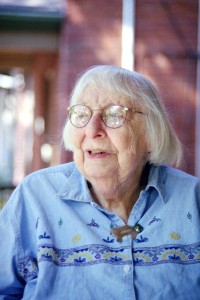Jane Jacobs – The Death And Life Of Great American Cities, 50 Years On. June 7, 2011 Niagara at Large online news
I wrote this piece with some thoughts about changing active transportation and street life in downtown St. Catharines, Canada.
Fifty years ago, we began to learn about city planning and living in a different way. The publication in 1961 of “Death and Life of Great American Cities” by Jane Jacobs turned a corner in the way we think about cities. The book still resonates with those who think and plan about the future directions of cities.
I first read the book, with wonder, about 1963. I began to imagine a different future for cities. Since that time, I have measured many of the city sights I see against the potentials that were held in Jane Jacob’s book and in her later publications about the economies of cities and regions.
In the mid-1990s Jane Jacobs and I became friends and our friendship continued until her death in 2006. I came to appreciate the way she thought about things. Her writing 50 years ago helped turn aside the linear way of thinking about traffic growth and subdivision sprawl. As time went on she described her ideas and writing as being interlaced like a spider’s web, “a web way of thinking”.

I produced an educational TV program about her entire work and the evolution of her ideas (Jane Jacobs: Urban Wisdom, 45 minutes, 2002). In a series of video interviews over the years, Jane reflected on her writing and her ideas. She called herself a non-fiction writer and resisted the “urban-guru” nomenclature.
In The Death and Life of Great American Cities, she felt the way streets worked was the key to understanding the potential of cities, “people weren’t just walking around or riding around with nothing on their minds but where they were doing all kinds of other things, by the way…the more you watched the more interesting and amazing connections you saw.
In the City of St. Catharines, for example, I have seen how a return to two-way traffic has again given pedestrians rights that had been lost to one-way traffic that was concentrating in getting through the area. It is interesting to watch cars now defer to pedestrians at crossings. A politeness has been achieved (mostly). Continue reading
